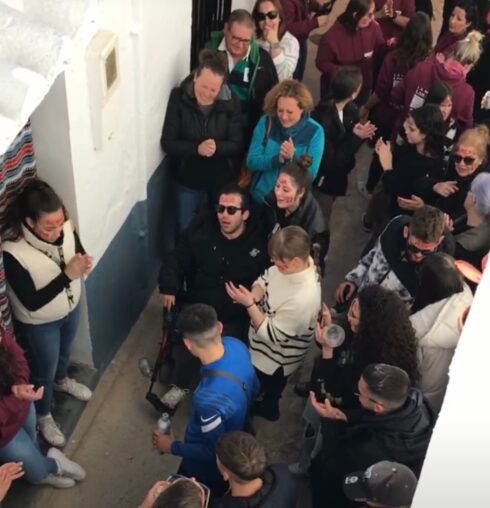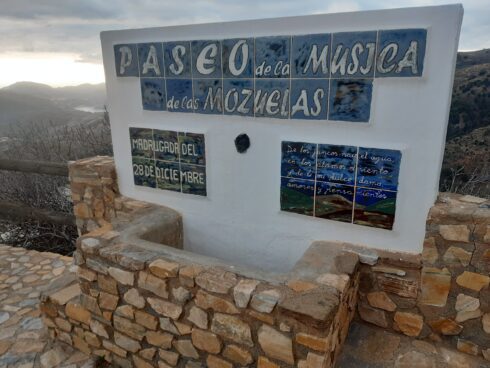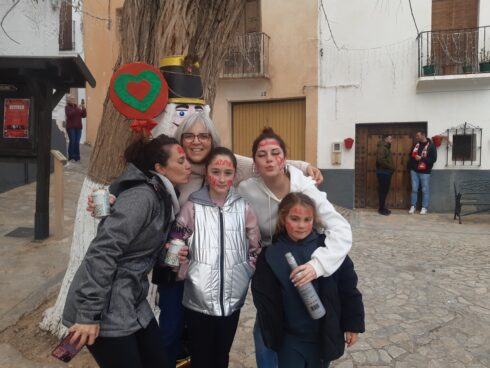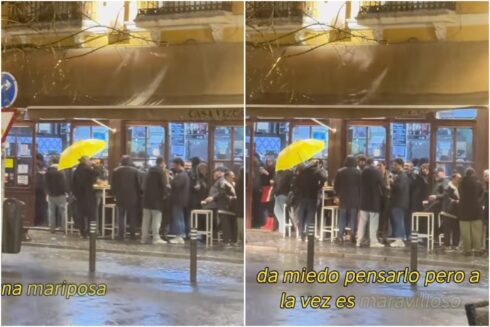by Jane Whyatt
In these days of hooking-up through dating apps such as Bumble and Tinder, young men no longer need to serenade young women beneath their balconies with music and song like Romeo and Juliet in Shakespeare’s play.
But in the tiny, remote village of Cañar near Granada, that’s exactly what they do.
Every year, starting a two o’clock in the morning on 28 December, the merry minstrels set off on their tour of the village. All the young men serenade all the young women. But to avoid misunderstandings, they also paint names and symbols on their faces using red paint.

Merriment is guaranteed by copious amounts of alcohol, especially the local costa red wine. Even the musical accompaniment includes percussion created by banging a fork on a bottle of anis, the traditional Andalucian aniseed liqueur. These days, bottles of Bailey’s Irish cream tipple are also popular. With maracas, cymbals and tambourines – as well as guitars and accordions – and up to forty lusty singers, the fiesta is LOUD.
Robin Smith, who owns a holiday home in Cañar, reflected ruefully the afternoon after the fiesta I didn’t get much sleep last night and it’s amazing that the party is still going on today…
His holiday business is thriving, with many ’active tourists’ keen to explore the Alpujarras on the many hiking trails. One, the European path GR 47, follows the ancient trade route from Tarifa near Gibraltar to Delphi in Greece. Hundreds of hardcore mountain-bikers pit their strength against the steep winding road to the white village perched 1,040 metres above sea level. There is no through road. So the return journey is just as challenging – with spectacular views to compensate for the wear and tear on the brakes – and on the nerves!

Still, hikers and bikers are thin on the ground in this fallow ’Twixmas’ time between Christmas and New Year. And the musica de las mozuelas (music of the maidens) festival is definitely not just for tourists. It seems it is not EVEN for tourists, although the date and route are marked by a blue-and-white-tiled plaque at the entrance to the village. Every family joins in, including young girls of primary school age and elderly widows who enjoy being serenaded by their neighbours, sons and grandsons.
Mayor Manuel Alvarez Guerrero, PSOE-A (Socialist workers’ party of Andalucia) is pleased that the tradition continues, attracting participants from nearby towns and villages:
The population of Cáñar is multiplied during this party in which there is a very lively atmosphere, since there are many people who come from different corners of the region and outside it to sing to the “mozuelas”, comments Guerrero.
In fact, the population is tiny. According to the website of the ayunamiento (municipality), Cañar has 397 inhabitants, of whom 211 are men and only 186 women. Perhaps it is this statistic that keeps alive the tradition of the serenades: with women in the minority, the men have to try that bit harder to impress the opposite sex…
More likely it’s the famous Spanish love for a good party. This one continues all night, ending up at 10 am with a communal brunch in the cafe-bar. After the meal-break, married men and some from the older generation join the tour as reinforcements, starting from where the last serenade was staged. This time around they ask for money. The donations… including some of as much as fifty euros… are collected in a piggy bank.

Then the bonfire is lit next to the church of Santa Ana in the village square. Like the fiesta, the architecture is unchanged since the Moors were expelled from Andalucia by Christians in 1492. The church replaced the mosque which originally stood on this site. But today the Christmas decorations include tinsel reindeer with little step ladders and face-shaped holes, where locals can pose for Instagram.
With their musical instruments and smiling, painted faces, the revellers are very photogenic. As the iconic Spanish poet Federico Garcia Lorca observed when he visited Cañar in 1926,
There are of course two perfectly defined races. The Nordic, Galician, Asturian, etc., and the purely preserved Moorish. People with blue eyes and people with… indescribable eyes. I saw a queen of Sheba shelling corn on a bitumen-colored and violet wall, and I saw a child king disguised as a barber’s son.
That visit inspired Lorca’s poem The Unfaithful Wife (La Casada Infiel in Spanish), based on a local folksong. It tells the story of a man who seduces a young maiden (mozuela) by the river – only to discover later that she is aleady married.
Lorca himself is immortalised here. Quotes from his poems are set in tiled plaques around the village and a large information board describes in detail his connections to the region.
Poetry, passion and polvorones (traditional almond-flavoured cookies) are the order of the day on 29 December. The fiesta continues. Villagers and visitors dance around the bonfire, the fountain and the Christmas tree, celebrating with firecrackers, party poppers and balloons.
And what about that piggy bank?
Well, it’s ceremonially smashed open and the coins and notes are collected to pay for sweets and presents for the children at the next fiesta. It’s only a week away, when the Feast of the Epiphany (Tres Reyes in Spanish) heralds the arrival in Cañar of the Three Kings, bearing gifts for Baby Jesus. Here in the mountains, they don’t come on camels. Not even on donkeys. No – Melchior, Caspar and Balthazar drive around the village on a tractor.
But that’s another story…









